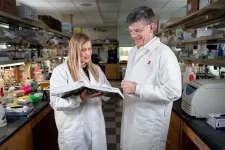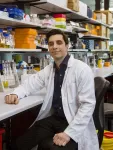(Press-News.org) “We find that a more sustainable, flexitarian diet increases the feasibility of the Paris Agreement climate goals in different ways,” says Florian Humpenöder, PIK scientist and co-lead author of the study to be published in Science Advances. “The reduction of greenhouse gas emissions related to dietary shifts, especially methane from ruminant animals raised for their meat and milk, would allow us to extend our current global CO2 budget of 500 gigatons by 125 gigatons and still stay within the limits of 1.5°C with a 50 percent chance,” he adds.
Putting a price on greenhouse gas (GHG) emissions in the energy and land system is an important policy instrument to stay within the limits of 1.5°C warming. “Our results show that compared to continued dietary trends, a more sustainable diet not only reduces impacts from food production within the land system, such as deforestation and nitrogen losses. It also reduces GHG emissions from the land system to such an extent that it cuts economy-wide 1.5°C-compatible GHG prices in 2050 by 43 percent,” explains co-lead author Alexander Popp, leader of the working group land-use management at PIK. "Moreover, healthy diets would also reduce our dependency on carbon dioxide removal in 2050 by 39 percent," he adds.
Flexitarian diet could make a marked difference for the feasibility of the 1.5°C target
Up to now, existing literature did not allow to single-out the contribution of dietary shifts alone for the feasibility of the 1.5°C limit. In the new study, PIK scientists investigated how dietary shifts would contribute towards the feasibility of 1.5°C transformation pathways relative to a scenario without dietary shifts. The researchers used the open-source Integrated Assessment Modelling framework REMIND-MAgPIE to simulate 1.5°C pathways, one including dietary shifts towards the EAT-Lancet Planetary Health Diet by 2050 in all world regions. "The EAT-Lancet Planetary Health Diet is a flexitarian diet predominantly featuring a wide variety of plant-based foods, a marked reduction of livestock products especially in high- and middle-income regions, and restricted intake of added sugars, among other things,” says co-author Isabelle Weindl from PIK.
However, considerable challenges are yet to be addressed: Decision-making in food policy is often dispersed across different institutions and ministries, which hinders the implementation of coherent policies in support of healthy diets. Moreover, social inclusion and compensation schemes are central for a just transition to healthy diets, the authors state.
„The results indicate that a shift in our diets could make a considerable difference if we do not want to crash through the 1.5°C limit in the next 10 to 15 years. This calls for globally concerted efforts to support the transition towards sustainable healthy diets,” concludes Johan Rockström, PIK director and co-author of the study.
END
Food matters: Healthy diets increase the economic and physical feasibility of 1.5°C
2024-03-27
ELSE PRESS RELEASES FROM THIS DATE:
Land under water – what causes extreme flooding
2024-03-27
There are several factors that play an important role in the development of floods: air temperature, soil moisture, snow depth, and the daily precipitation in the days before a flood. In order to better understand how individual factors contribute to flooding, UFZ researchers examined more than 3,500 river basins worldwide and analysed flood events between 1981 and 2020 for each of them. The result: precipitation was the sole determining factor in only around 25% of the almost 125,000 flood events. Soil moisture was the decisive factor in just over 10% of cases, and ...
Understanding why people sell their kidneys
2024-03-27
A systematic review of 35 years of global medical literature finds a spectrum of reasons why people sell kidneys. The study, by Bijaya Shrestha of the Center for Research on Education, Health and Social Science, Kathmandu, Nepal, finds limited efforts toward mitigating the problem as well as a lack of evidence around the impact of policy and biotechnology. It is published in the open access journal PLOS Global Public Health.
Demand for kidney donation is higher than supply, and it has become one of the most saleable human ...
Researchers turn back the clock on cancer cells to offer new treatment paradigm
2024-03-27
St. Jude Children’s Research Hospital scientists reversed an aggressive cancer, reverting malignant cells towards a more normal state. Rhabdoid tumors are an aggressive cancer which is missing a key tumor suppressor protein. Findings showed that with the missing tumor suppressor, deleting or degrading the quality control protein DCAF5 reversed the cancer cell state. These results suggest a new approach to curing cancer — returning cancerous cells to an earlier, more normal state rather than killing cancer cells with toxic therapies — may be possible. The results were published today in Nature.
“Rather than making a toxic event that kills rhabdoid ...
SwRI leads airborne, ground-based 2024 eclipse observation projects
2024-03-27
SAN ANTONIO — March 27, 2024 —Southwest Research Institute is leading two groundbreaking experiments — on the ground and in the air — to collect astronomical data from the total solar eclipse that will shadow a large swath of the United States on April 8, 2024. SwRI’s Dr. Amir Caspi leads the Citizen Continental-America Telescopic Eclipse (CATE) 2024 experiment, a broad scientific outreach initiative funded by the National Science Foundation (NSF) and NASA, that will ...
Lighting up the future
2024-03-27
New multidisciplinary research from the University of St Andrews could lead to more efficient televisions, computer screens and lighting.
Researchers at the Organic Semiconductor Centre in the School of Physics and Astronomy, and the School of Chemistry have proposed a new approach to designing efficient light-emitting materials in a paper published this week in Nature (27 March).
Light-emitting materials are used in organic light-emitting diodes (OLEDs) that are now found in the majority of mobile ...
Sweet success: researchers crack sugarcane’s complex genetic code
2024-03-27
Modern hybrid sugarcane is one of the most harvested crops on the planet, used to make products including sugar, molasses, bioethanol, and bio-based materials. It also has one of the most complex genetic blueprints.
Until now, sugarcane’s complicated genetics made it the last major crop without a complete and highly accurate genome. Scientists have developed and combined multiple techniques to successfully map out sugarcane’s genetic code. With that map, they were able to verify the specific location that provides resistance to the impactful brown rust disease ...
WISPR team images turbulence within solar transients for the first time
2024-03-27
WASHINGTON — The Wide-field Imager for Parker Solar Probe (WISPR) Science Team, led by the U.S. Naval Research Laboratory (NRL), captured the development of turbulence as a Coronal Mass Ejection (CME) interacted with the ambient solar wind in the circumsolar space. This discovery is reported in the Astrophysical Journal.
Taking advantage of its unique location inside the Sun’s atmosphere, the NRL-built WISPR telescope on NASA’s Parker Solar Probe (PSP) mission, operated by the Johns Hopkins University Applied Physics Laboratory (JHUAPL), captured in unparalleled detail the interaction between ...
Undocumented immigrants faced unique mental health challenges during COVID-19 pandemic
2024-03-27
Four years after the U.S. shut down in the face of the COVID-19 pandemic, research from Rice University suggests undocumented immigrants’ mental health challenges were compounded due to stresses stemming from their unauthorized status.
“Implications of Undocumented Status for Latinx Families During the COVID-19 Pandemic: A Call to Action” appears in the Journal of Clinical Child & Adolescent Psychology and examines how undocumented immigrants navigated the COVID-19 pandemic.
During a series of in-depth interviews with undocumented individuals or those from ...
Old immune systems revitalized in Stanford Medicine mouse study, improving vaccine response
2024-03-27
Planes, trains, boats, automobiles and even feet. During the past decades and centuries, global travel and human migration have made all of us more worldly — from our broadening awareness of the world beyond our birthplaces, to our more sophisticated palates, to our immune systems that are increasingly challenged by unfamiliar bacteria and viruses.
In the elderly, these newly imported pathogens can gain the upper hand frighteningly quickly. Unfortunately, however, vaccination in this age group isn’t as effective as it is in younger people.
Now a study conducted in mice by Stanford ...
Discovery has potential to solve the billion-dollar global cost of poorly managed wound healing
2024-03-27
Scientists have uncovered a key step in the wound healing process that becomes disabled in diseases like diabetes and ageing, contributing to a global healthcare cost of managing poorly healing wounds exceeding $250 billion a year. Importantly, the research published in Nature reveals a molecule involved in the healing of tissues that – when injected into animal models – leads to a drastic acceleration of wound closure, up to 2.5 times faster, and 1.6 times more muscle regeneration.
Lead researcher, Associate Professor Mikaël Martino, from Monash University’s Australian Regenerative Medicine Institute (ARMI) in Melbourne, Australia, said the discovery ...






